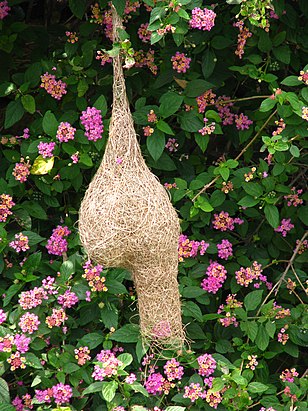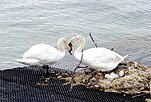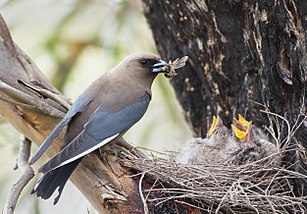Nest
Anestis a structure built for certain animals to holdeggsor young. Although nests are most closely associated withbirds,members of all classes ofvertebratesand someinvertebratesconstruct nests. They may be composed of organic material such as twigs, grass, and leaves, or may be a simple depression in the ground, or a hole in a rock, tree, or building. Human-made materials, such as string, plastic, cloth, or paper, may also be used. Nests can be found in all types ofhabitat.
Nest building is driven by a biological urge known as thenesting instinctin birds and mammals. Generally each species has a distinctive style of nest. Nest complexity is roughly correlated with the level of parental care by adults. Nest building is considered a key adaptive advantage among birds, and they exhibit the most variation in their nests ranging from simple holes in the ground to elaborate communal nests hosting hundreds of individuals. Nests ofprairie dogsand severalsocial insectscan host millions of individuals.
Nest building[edit]
Purposes of nesting[edit]
Structural purposes[edit]
Nest building (nidification) is often driven by a biological urge inpregnantanimals to protect one's offspring known as thenesting instinct.Animals build nests to protect theireggs,their offspring, or themselves from danger. The simplest nest structures are adapted to hide eggs frompredators,shield them from the sun or other environmental factors, or simply keep them from being scattered inocean currents.In some cases, nests also help providesafety in numbersfor egg-laying animals.[1]
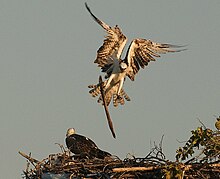
Social purposes[edit]
Many nest builders provide parental care to their young, while others simply lay their eggs and leave.Brooding(incubating eggs by sitting on them) is common among birds. In general, nest complexity increases in relation to the level of parental care provided.[1]Nest building reinforces social behavior, allowing for larger populations in small spaces to the point of increasing thecarrying capacityof an environment. Insects that exhibit the most complex nidification also exhibit the greatest social structure. Among mammals, thenaked mole-ratdisplays acastestructure similar to thesocial insectswhile building extensiveburrowsthat house hundreds of individuals.[2]
Usage of environment[edit]
Versatility in use of construction material may be an adaptive advantage (less energy used to gather materials) or a disadvantage (less ability to specialize construction). The available evidence suggests thatnatural selectionmore often favorsspecialization over flexibilityin nest construction.[2][why?]
At the most basic level, there are only two types of nest building: sculpting and assembly.
Sculpting[edit]
Sculpting is the process of removing material to achieve the desired outcome. Most commonly this entails burrowing into the ground or plant matter to create a nesting site.
Assembly[edit]
Assembly entails gathering, transporting, and arranging materials to create a novel structure. Transportation has the greatest time and energy cost so animals are usually adapted to build with materials available in their immediate environment.
Building materials[edit]
Plant matteris the most common construction material for nests. Other common materials includefurorfeathers,perhaps from the animal itself,mudordirt,fecal matter,and specializedsecretionsfrom the animal's body.
Effects on environment[edit]
Nest building can have a substantial impact on the environment in which animals live. The combineddiggingactivity oftermitesandmole-ratsinSouth Africahas created a "mima prairie" landscape marked by huge areas of flat land punctuated by mounds 30 metres (98 ft) wide and 2 metres (6.6 ft) high. Similar structures exist in theUnited States,created bypocket gophers,andArgentina,rodents of the genusCtenomys.
Lasting effects[edit]
Nests constructed bymegapodebirds have been mistaken foranthropologicalfeatures by professionals, due to their exceptional height (10 metres [33 ft]) and abundance (hundreds in a single location).[2]
Nest builders[edit]


Nest architecture may be as useful for distinguishing species as the animals' physical appearance. Species identified through such means are calledethospecies.This is especially common in wasps and termites, but also can apply to birds. In most animals, there is some variation in nest construction between individuals. Whether these differences are driven by genetics or learned behavior is unknown.[2]
With the exception of a few tunneling mammals, nest builders exhibit no specialized anatomy, instead making use of body parts primarily used for other purposes. This is possibly due to the sporadic nature of nest building, minimizing the selective pressures of anatomy used for nest building.[2]
Birds[edit]
In general, birds are the most skilled nest builders, although not all species of birds build nests, some laying theireggsdirectly onto rock ledges or bare soil without first modifying the area. Complex nest building is considered to be one of the key adaptive advantages of birds.[1]Nests help regulate temperature and reduce predation risks, thus increasing the chance that offspring live to adulthood.[2]
Bird nests vary from simple depressions in the ground known as scrapes to largely unstructured collections of branches to elaborately woven pendants or spheres. Themegapodes,one of the few groups who do not directly brood their young, incubate their young in a mound of decomposing vegetation. One species,Macrocephalon maleo,uses volcanic sand warmed by geothermal heat to keep its eggs warm.[1]Among the simple nest builders arefalcons,owls,and manyshorebirds.Theweaversexhibit perhaps the most elaborate nests, complete with strands of grass tied into knots. Most bird nests lie somewhere in the middle, with the majority building cup-shaped nests using some combination of mud, twigs and leaves, and feathers. Some birds, suchflamingosandswifts,use saliva to help hold their nest together. Theedible-nest swiftletuses saliva alone to construct their nests.[3]Therufous horneronest is composed entirely of mud and feces, which is placed on tree branches to allow the sun to harden it into a usable structure.[4]Thetailorbirdsstitch together leaves to provide cover for their nest sites.[1]

Thesociable weaverbuilds large communal nests in which many individual nests reside. They divide the nest using walls of grass placed atop a base of large sticks. At the entrances to the nest, sharp sticks are placed to ward off intruders.[4]A single communal site can measure 2 metres (6.6 ft) in height and 8 metres (26 ft) in width. As many as 300 mating pairs may reside in the structure.[5]Other birds often built their own nests on top of Weaver nest sites.[4]
Some birds build nests intrees,some (such aseagles,vultures,and manyseabirds) will build them on rocky ledges, and others nest on the ground or inburrows.[3]Each species has a characteristic nest style, but few are particular about where they build their nests. Most species will choose whatever site in their environment best protects their nest, taking into account the nest's style. Several species will build on a cactus whenever possible. ThebushtitandBullock's oriolewill suspend their nests from the tips of slender branches.[1]Theoropendolastake hanging nests to the extreme, constructing pouches up to 1.8 metres (5.9 ft) tall using hanging vines as their base.[1][4]The hanging nest is attached to thin tree branches, discouraging predation.[4]Other species seek out crevices, using buildings or birdhouses when tree holes are not available.[1]
Typical bird nests range from 2 centimetres (0.79 in) in size (hummingbirds) to 2 metres (6.6 ft) (eagles) in diameter.[3]The largest nest on record was made by a pair ofbald eagles.It was 2.9 metres (9.5 ft) in diameter, 6 metres (20 ft) deep and was estimated to weigh more than 2 tonnes (4,400 lb).[6]The lightest bird nests may weigh only a few grams.[3]Incubation mounds of themallee fowlcan reach heights of 4.57 metres (15.0 ft) and widths of 10.6 metres (35 ft). It is estimated the animal uses as much as 300 tonnes (660,000 lb) of material in its construction.[5]The extinctSylviornis neocaledoniaemay have constructed nesting mounds 50 metres (160 ft) in diameter.[2]
Mammals[edit]

Many species of small mammals such asrodents,rabbits,andground squirrelsdigburrowsinto the ground to protect themselves and their young.[7]Prairie dogsbuild an elaborate system of tunnels which can span large stretches of land. One such structure, called a town, spanned 25,000 square miles (65,000 km2) and held an estimated 400 million individuals. Their homes are adapted to withstand large (above-ground) temperature variation, floods, and fire. Their young are raised in the deepest chambers where the temperature is the most stable.[4]
Many mammals, includingraccoonsandskunks,seek natural cavities in the ground or in trees to build their nests. Raccoons, and some rodents, use leaves to build nests underground and in trees.Tree squirrelsbuild their nests (dreys) in trees, whilevolesnest in tall grass.[7]In some species, the nest serve as homes for adults while in others they are used to raise young. Theduck-billed platypusand theechidnalay eggs in nests.[3]
Gorillasbuild fresh nests daily out of leaves and other vegetation in which they sleep at night. They sometimes also build nests during the day for resting in. The smaller species of gorilla build their nests in trees, while the larger are confined to the ground. Nests of thewestern gorilla,the largest species, measure about 1 metre (3.3 ft) in diameter.[8]
Amphibians[edit]

Some species of frog build nests ranging from simple to modest complexity.[3]Many stream-dwelling frogs lay their eggs in a gelatinous mass which they attach to underwater vegetation to prevent eggs from washing away.[1]Nests can have other protective qualities. For example, the femaleFletcher frogbeats secreted mucus into a froth, creating a structure that serves as a line of defense against thermal extremes, predation, and desiccation.
Fish[edit]
Fish engage in nest building activities ranging from simply scooping out sediment to building enclosed structures out of plant matter. Malesticklebacksproduce a special enzyme in their kidneys that they use to bind plants together.[3]
Reptiles[edit]
TheAmerican alligatoris known for its parenting skills. They build large nests of mud and vegetation on river banks or vegetation mats. The female digs a hole in the center to lay her eggs, covers them, and then guards them for two months until they hatch. When eggs start to hatch, she breaks open the nest which has hardened over time and leads the young to the water where she continues to care for them for another year. Alligators are very particular about their nesting sites and will abandon a site if things go wrong.[1]
Cobrasuse leaves and other debris to build nests in which they lay eggs that both sexes guard. They carry the vegetation to the nest site by kinking their necks.[3]Sea turtlesdig a hole in the sand above the high tide line in which they lay their eggs. They then cover the soft eggs to protect them from the sun and predators and leave.[1]
Dinosaurs[edit]
From the fossil record, it is known that many, or perhaps all,dinosaurslaid eggs. Paleontologists have identified a number of features that allow them to distinguish a nesting site from a random clustering of eggs. Those include regular clustering patterns, the co-occurrence of whole eggs with broken eggs and/or hatchlings, and the occurrence of physical features such as evidence of excavation.[1]

TheOviraptornests ofMongoliaare perhaps the most famous case of dinosaur nesting. One specimen was found fossilized atop a nest in a brooding posture, proving the animal had been poorly named (Oviraptor means "egg taker" ).[1]
A site known asEgg MountaininMontanaprovides exceptional evidence of dinosaur nesting behavior. The site features dozens of nests each with 20 or more eggs belonging to theMaiasaura.Juvenile teeth at the site exhibit signs of wear, while the leg bones are not developed enough to walk. This allowed scientists to conclude that the species provided extensive parental care for its young. It is likely the species covered its nests with sand and vegetation to keep them warm and nested in colonies for increased protection.[1]
Insects[edit]
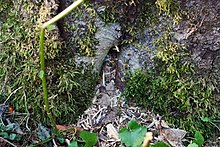
Social insects,including most species ofants,bees,termites,andwasps,are nest builders. Their often elaborate nests may be found above or below ground. Features often include ventilation systems and separate chambers for the queen, her eggs, and developing individuals.[3]
Bees andhornetsoften seek out natural cavities in which to construct their nests, also known as hives, in which they store food and raise their young. Other species of bee and some wasps dig holes in the ground or chew through wood.[7]In the speciesMegachile rotundata,for example, females construct tubular-shaped nests in rotting wood as well as small holes in the ground, creating, each cell made from circular disks cut from plant leaves using the bee's mandibles.[9]Bee nests are founded upon the wax the secrete from their bodies, while those of wasps are dependent on their ability to turn plant water into paper using their saliva.[2]Nests often exhibit divided living, with eggs and food stores kept in distinct parts of the hive.[7]Vespid waspsbuild complex nests from paper-like material where they lay eggs in individual cells. When the young hatch, their parents feed them chewed up larvae. Different species exhibit different nest structures.Paper waspnesting consist of a single tier of cells, whileyellow jacketnests can be many layers thick, reaching up to 30 centimetres (0.98 ft) in diameter.[1]Nesting strategies can be plastic, for instance the waspParischnogaster mellyiwill significant vary its nest construction based on environmental conditions, and the waspMischocyttarus mexicanusis known to nest in groups or alone depending on the distribution of potential nest sites in the area.[2][10]Nest sizes vary dramatically and the largest wasp nest on record measured 1.75 metres (5.7 ft) in diameter and was 3.7 metres (12 ft) tall. Found in New Zealand, it was likely built by theGerman wasp.[11]

Termites build elaborate nests that span multiple generations and may last decades.[2]Using chewed wood, mud, and feces they build large mounds which may extend well into the air.[4]The largest nests, built by members of genusAmitermes,stand nearly 7 metres (23 ft) tall with a similar circumference at the base, and host millions of individuals.[2]Termite mounds are constructed to allow for excellent air flow, regulating the mound temperature. The mounds protect against drying and predation allowing many species to lose ancestral traits such as hard bodies, skin pigmentation, and good eyesight.Magnetic termitesconstruct their nests with flattened sides along the north–south axis to ensure maximum warming during the winter, while exposing minimal surface area to the harshest mid-day sunshine.[2]Other termite species use their nests to farm fungi.[4]
Ant nests feature an elaborate colony structure that may extend 2 metres (6.6 ft) or more underground. As the structure gets further underground, individual chambers become farther and farther apart indicating that the ant is aware of its depth. It is hypothesized that they accomplish this by sensing the level ofcarbon dioxidein the soil.[4]Theleaf cutter antbuilds a complex nest which can house 8 million individuals. Its nests feature numerous chambers, most notably garden chambers where they farm fungus on leaves they harvest from the forest.[2]
Species such as thecarpenter antand the waspPolistes exclamansbuild "satellite nests" - smaller nests near, but separate from, the main nest.[12][13]These satellite nests are used as an insurance against predators andparasites;if the original nest is attacked, surviving members can move the satellite nest.[12]Other species such as the Black hover wasp,Parischnogaster alternata,construct nests in clusters with the central core composed of older colonies surrounded by younger colonies.[14]
The Eastern carpenter bee,Xylocopa virginica,is unique in that individuals of that species build their nests in wood, bamboo culms, agave stalks, and other similar materials, although their preferred nesting material is pine or cedar lumber. When digging the nests, they use the wood shavings scraped from the wall to create partitions within the tunnels. The nests are usually round and have about 1-4 tunnels, each with multiple branches. Because these materials are often useful for humans in construction,X. virgininica'snesting behavior presents the disadvantage of weakening wood in manmade structures.[15]
Effects on other species[edit]
The abundance of biological resources within the nest has led to a number of specialized predators. Theaardvarkand theant eateruse long tongues to prey upon termite and ant nests. Birds such as thehoney buzzardspecialize on wasp and bee nests, a resource also targeted by thetropical hornet.Symbiosis,ranging from feeding on waste toobligate parasitism,is common within the nest. Ant nests alone support symbiotes spanning six classes ofarthropodswhich includes 35 families just from thebeetles.[2]
Names of nests[edit]
- Abadger's nest is called asett.
- Abeaver's nest is called alodge.
- Aneagle's nest is called an eyrie.[16]
- Anotter's den is called aholtor a couch.
- Apheasant's nest is called a nide.[17][vague]
- Arabbit's nest is called a form.[18]
- Asquirrel's orringtail possum's nest is called adrey.
- Awasp's nest is called a vespiary.[19]
See also[edit]
References[edit]
- ^abcdefghijklmnoTom Deméré; Bradford D. Hollingsworth (Spring 2002)."Nests and Nest-building Animals"(PDF).San Diego Natural History Museum.Archived(PDF)from the original on 2022-10-09.RetrievedAugust 19,2013.
- ^abcdefghijklmnMike Hansell (2000).Bird Nests and Construction Behaviour.Cambridge University Press.ISBN978-0521460385.
- ^abcdefghi"nest".Encyclopædia Britannica.Archivedfrom the original on September 30, 2013.RetrievedAugust 19,2013.
- ^abcdefghiMary Beth Griggs (2011-05-26)."8 Amazing Architects of the Animal Kingdom".Popular Mechanics.Archivedfrom the original on August 13, 2013.RetrievedAugust 22,2013.
- ^ab"Most populous bird's nest".Guinness World Records.Archivedfrom the original on August 21, 2014.RetrievedAugust 20,2013.
- ^"Largest bird's nest".Guinness World Records.RetrievedAugust 20,2013.
- ^abcd"Mammal Nests and Burrows".Kids' Inquiry of Diverse Species.University of Michigan.Archivedfrom the original on December 3, 2013.RetrievedAugust 20,2013.
- ^"Largest mammal to build a nest".Guinness World Records.RetrievedAugust 20,2013.
- ^Milius, Susan (2007-01-06). "Most bees live alone: No hives, no honey, but maybe help for crops".Science News.171(1): 11–13.doi:10.1002/scin.2007.5591710110.ISSN1943-0930.
- ^Clouse, R. (2001). “Some effects of group size on the output of beginning nests ofMischocyttarus mexicanus(Hymenoptera: Vespidae).”Florida Entomologist.84(3):418-424.
- ^"Largest wasp nest".Guinness World Records.Archivedfrom the original on July 2, 2013.RetrievedAugust 20,2013.
- ^abJoan E. Strassman (1981). "Evolutionary implications of early male and satellite nest production inPolistes exclamanscolony cycles ".Behavioral Ecology and Sociobiology.8(1): 55–64.doi:10.1007/BF00302844.S2CID40390603.
- ^Jeff Hahn; Colleen Cannon; Mark Ascerno (2008)."Carpenter ants".University of Minnesota.Archivedfrom the original on September 10, 2013.RetrievedAugust 20,2013.
- ^Landi, M., C. Coster-Longman, and S. Turillazzi. "Are the Selfish Herd and the Dilution Effects Important in Promoting Nest Clustering in the Hover Wasp (Stenogastrinae Vespidae Hymenoptera)?" Ethology Ecology & Evolution 14.4 (2002): 297-305. Web.
- ^Balduf, W. V. (1962-05-01). "Life of the Carpenter Bee, Xylocopa virginica (Linn.) (Xylocopidae, Hymenoptera)". Annals of the Entomological Society of America 55 (3): 263–271. doi:10.1093/aesa/55.3.263. ISSN 0013-8746.
- ^"eyrie",The Free Dictionary,retrieved2020-04-21
- ^"nide",The Free Dictionary,retrieved2020-04-21
- ^Barbe-Julien, Colette (2006),Little Rabbits,Milwaukee, WI: Gareth Stevens, p. 3,ISBN978-0-8368-6699-5
- ^"vespiary",The Free Dictionary,retrieved2020-04-21
External links[edit]
- Birds as Builders of Homes
- Ingersoll, Ernest(1920)..In Rines, George Edwin (ed.).Encyclopedia Americana.
- Ingersoll, Ernest (1920)..In Rines, George Edwin (ed.).Encyclopedia Americana.

